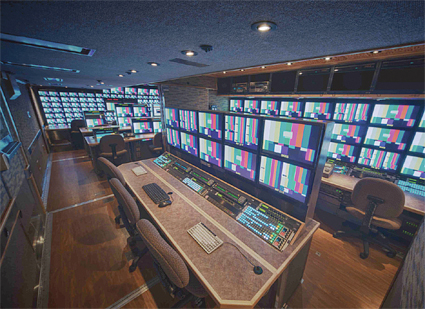Familiar on the Outside, New on the Inside
LAKE BLUFF, ILL.—At first glance, Corplex's new Chromium 53-foot expando HD Mobile Unit (HDMU) looks a lot like the company's Iridium HDMU. In fact, the two production trailers look very similar outside, and have the exact same floor layout inside.

Corplex’s New Chromium 53-foot expando HDMU But appearances are deceiving: The Chromium HDMU is three years newer than Iridium, and its technology and capabilities reflect this fact.
TIME FOR A THIRD
Corplex is a "boutique" mobile production company based in Lake Bluff, Ill. The term "boutique" means that this is a small company that only had one HD truck—Platinum—when it began leasing HD mobile production facilities in 2004.
"We began as an engineering company in 1985, and built our first SD truck in 1998 for which we won an NAB award," says Scott West, Corplex's president. "We built the Platinum HDMU and its B unit Mercury to meet customer demands in 2004; followed by Iridium and its B unit Zinc in 2008."
Iridium has been leased by many major U.S. broadcasters and sports networks since its launch, and has generally been well-received. So when demand began to outstrip Corplex's two-truck capacity, it made sense for the company to build a third truck based on Iridium's specs. After all, Iridium was what most customers were asking for.
"The truth is that Chromium was originally intended to be a second Iridium," West tells TV Technology. "After all it made sense to not reinvent the wheel when we'd already nailed the basic design. But advances in technology soon convinced us that it made sense to equip Chromium differently. In particular, we wanted to build a truck that was cutting-edge for the next 10 years." (Note: Chromium has its own B unit truck, named "Nickel.")
3G READY

Chromium’s master control is built around a Grass Valley Kayenne production system. One key upgrade in Chromium is its Grass Valley Kayenne production switcher. This is a 96 input, 35 button unit with all DPM engines, a four channel Summit Clipstore, two Chroma keyers, and a Device Control Module.
Kayenne replaced the Kalypso, which can be found inside the company's Iridium and Platinum HDMUs, according to West. "This is a 3G-capable unit with modern functionality for both 1080i and 720p sports/entertainment mobile production," he said. Add the Evertz EQX 3G video router (452x1066)—paired with an EMR audio router that didn't exist when Iridium was built—and Chromium's audio/video handling capability has enough headroom for years to come. (Note: Chromium records video to EVS XT 2 servers, as does Iridium and Platinum.)
Another important upgrade inside Chromium is the Apollo Calrec 128 fader audio console. "This board has twice the number of faders found in our previous Calrec Sigma audio consoles," Scott says. "128 faders means that today's producers can have all of their audio channels on the top level—even in a 5.1 environment."
Worth noting: Chromium supports the embedding and de-embedding of 5.1 audio within HD video channels. "Without embedding, you typically are confined to recording four audio channels to a single EVS record channel," said Dave Greany, Corplex's vice president of engineering and remote operations for Corplex. "However, because embedding allows you to put the audio together with the HD video feed, you can now include up to 16 audio inputs on one EVS channel. This allows our clients to work with multiple 5.1 feeds, which is what they have been asking for."
Finally, Chromium is equipped with 10 Sony HDC-1500R 3G fiber/triax cameras (with wiring in place to support 18). This means that the truck is ready to shoot 3G when necessary. "Granted, the Kayenne is not native 3G—no switcher is yet—but it can be configured to handle 3G by simply by combining two video channels," West notes. "So we're ready for the future."
At press time, Chromium had already hit the road for CBS Sports and Major League Baseball. Because this HDMU is not assigned to a specific client, it will likely be used by every major network and sports broadcaster during its lifespan.
"As a boutique mobile company, our trucks need to be highly flexible and configurable," Scott West says. "Chromium meets both of these requirements, with room to add new capabilities as the industry evolves. And yes, it does look like Iridium—but Chromium is anything but a clone."
The professional video industry's #1 source for news, trends and product and tech information. Sign up below.
James Careless is an award-winning journalist who has written for TV Technology since the 1990s. He has covered HDTV from the days of the six competing HDTV formats that led to the 1993 Grand Alliance, and onwards through ATSC 3.0 and OTT. He also writes for Radio World, along with other publications in aerospace, defense, public safety, streaming media, plus the amusement park industry for something different.

